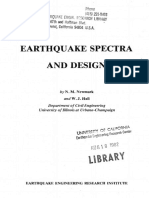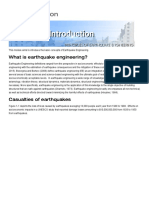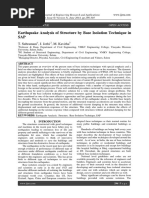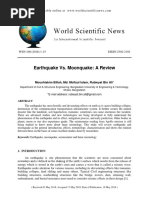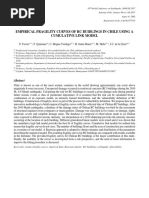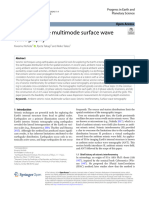EQ Chapter 1
EQ Chapter 1
Uploaded by
Ramon P. TanglaoCopyright:
Available Formats
EQ Chapter 1
EQ Chapter 1
Uploaded by
Ramon P. TanglaoOriginal Description:
Copyright
Available Formats
Share this document
Did you find this document useful?
Is this content inappropriate?
Copyright:
Available Formats
EQ Chapter 1
EQ Chapter 1
Uploaded by
Ramon P. TanglaoCopyright:
Available Formats
CHAPTER 1
INTRODUCTION
Background of the Study
Earthquakes are natural phenomena that occur when massive portions of
the earth move. During an earthquake, infrastructures collapse due to the intense
stress applied by the movement of the soil below the base of the building. An
infrastructure that collapses due to an earthquake whilst occupied by people is
already a disaster by itself.
As what happened in Kobe in 1995, it was struck by a 6.9-magnitude
earthquake that ruined 150,000 properties, leaving 300,000 homeless and 6,300
people lost their lives (Kohlstedt, 2017).
Also, earthquakes during this century would be the 7.0-magnitude
earthquake in Haiti that killed an estimated 316,000 people in 2010, claiming
more lives as a percentage of a country’s population than any recorded disaster.
On the 10th of February 2017, a strong earthquake of magnitude 6.7
shook the island of Mindanao. The epicenter is located 16 km offshore northwest
of Surigao City, Surigao Strait at a depth of 10 km. 300 houses in Surigao del
Norte were damaged following the earthquake and a total of seven bridges
collapsed, isolating the provincial city of San Francisco. There were at least
eleven towns affected and all were experiencing power outages (Phivolcs, 2017).
Due to the lack of real earthquake simulation it resulted into buildings
insufficiently braced for lateral loads or the shaking side to side. The researchers
need to address these problems since the number of developing infrastructures
2
are increasing rapidly and more people could perish if an earthquake would
occur.
To create a design which may be strong enough to withstand an
earthquake, we should first know how an earthquake affects the structure of an
infrastructure. One way of understanding how an infrastructure behaves under
stress from an earthquake would be to create an earthquake simulation. By doing
so, it will help us to understand infrastructure and earthquake behavior, which will
act as a catalyst for engineers to create new designs for infrastructures to
withstand earthquakes.
With the number of deaths that earthquakes cause globally, nationally and
locally, the researchers came up with a study entitled “Earthquake Simulator
using Secondary Seismograph Data”, a full-scale shake table that processed the
frequency, type, and size of the ground’s motion in reference to the statistics and
data gathered on previous earthquakes. With this study, it will help engineers and
engineering students specifically, those in the Civil Engineering and Architecture
discipline to understand and to learn how infrastructures behave under an
earthquake.
Research Objectives
The main purpose of this study was to create an earthquake simulator
using secondary seismograph data that can be used in experiments or studies
related to infrastructure design. The simulator interpreted the seismograph data
into a full-scale earthquake.
3
Specifically, the simulator could (a) aid civil engineering students to
conduct tests in order to determine the proper materials and designs of
infrastructures where it can stand the devastating effects of earthquakes, (b)
mimic the Shearing Waves (North to South) and Surface Waves (East to West)
at a full-scale magnitude, and (c) to simulate notable earthquakes.
Review of Related Literature
An earthquake is one of the most dangerous and destructive natural
occurrences known to man. It is the shaking of the surface of the Earth, resulting
from the sudden release of energy in the Earth's lithosphere and creates seismic
wave. Earthquakes have caused the dramatic collapse and destruction of
freeways, bridges and other structures built according to stringent earthquake-
resistant design codes. Numerous major earthquakes had already happened in
countries located all over the world, including the Philippines; examples are the
1968 Casiguran and 1976 Moro Gulf earthquakes. The devastating effects of
earthquakes prompted the interests of the researchers to the construction of
shake tables (Sabillo, 2013).
According to the book “Earthquake Engineering Structural Dynamics”, the
earliest known hand-powered shake table was constructed in Japan at the end of
the 19th century. At the beginning of the 20th century, the developments had
moved to Stanford University with the introduction of an electric motor to produce
a more refined oscillatory motion in one direction (Severn, 2010)
The study of ’Shake Table’ (Stauffer, 1997) stated that MIT researchers
and their collaborators prepared a conceptual design for a 30-by-30-meter
4
“shake table” that can subject a full-scale building or other structure of the forces
of a real earthquake. This allowed them to study the durability of a building and
improve the building’s structure and design. However, the researchers estimated
that operating the table would produce forces equivalent to those of a 4.5
magnitude earthquake in their region, which then led them to develop the half-
scale prototype shake table.
Dr. Anthony Ingraffea, Professor of the Cornell School of Civil and
Environmental Engineering recognized that his students were immersed in theory
and could benefit from a dose of practical application. An earthquake simulator
table is a very big leap towards engaging students to hands on approach of
learning. Practical learning is very essential since students would be able to
develop the skill to apply the theories into real life. This skill is somewhat lacking
in modern times. Many students can be very good with theories, but very bad at
applying it into real life situations.
Moreover, other study outlines that a shake table is an important teaching
tool, useful in presenting to aspiring architects and engineers how particular
structures respond during seismic events (Brown, 2007). “Having the ability to
simulate an earthquake gives us much better understanding of building
performance,” says Professor Shirley Dyke from Purdue University. Professor
Dyke is the driving force behind UCIST – University Consortium on Instructional
Shake Tables she helped start in 1999. The main goal of UCIST is to bring
earthquake simulators to classrooms – so that students early in their
undergraduate courses get a chance to develop understanding of structural
5
dynamics and controls principles through hands-on experiments in addition to
theory. “Hands-on experiments seem to be particularly effective for teaching
basic concepts in dynamics and control,” continues Prof. Dyke, “they are
attractive supplement to the rather conventional content of several courses.”
Conceptual Framework
INPUT PROCESS OUTPUT
Conversion of Earthquake
Seismograph Data
digital data to movement
motion simulated
Figure 1. Conceptual Framework of the Earthquake Simulator
The figure above shows the conceptual framework of the Earthquake
Simulator. The inputs of the simulator were the seismograph data that was
gathered from past notable earthquakes. The data consisted of the Shear and
Surface wave seismograph – which was then converted into a code readable by
the microcontroller. The microcontroller sent signals to the motors to move in
such a way that simulated the chosen earthquake. The motion, which was the
output of the simulator, mimicked the movement of the earthquake at a full-scale.
The simulator had two linear actuators, one for each axis, which moved
independently since an earthquake can have shear and surface waves at the
same time.
You might also like
- 000 Diseño Por Capacidad - 2003 - Myths and Fallacies in Earthquake Engineering - Priestley Pag20Document98 pages000 Diseño Por Capacidad - 2003 - Myths and Fallacies in Earthquake Engineering - Priestley Pag20Roberto UrrutiaNo ratings yet
- 1982 Newmark Hall EERI Earthquake Spectra and Design PDFDocument102 pages1982 Newmark Hall EERI Earthquake Spectra and Design PDFEmanuelRodriguezElera100% (3)
- Scientific Software Design The Object Oriented Way PDFDocument406 pagesScientific Software Design The Object Oriented Way PDFTarek Fouda100% (1)
- 1982 Newmark Hall Eeri Earthquake Spectra and DesignDocument103 pages1982 Newmark Hall Eeri Earthquake Spectra and DesignSarrows PrazzapatiNo ratings yet
- Earthquake EngineeringDocument348 pagesEarthquake EngineeringNaim DemiriNo ratings yet
- Development of Small Scale Models For K 12 and Undergraduate Students To Demonstrate Earthquake Effects On Building Structures and Aseismic Design ProceduresDocument23 pagesDevelopment of Small Scale Models For K 12 and Undergraduate Students To Demonstrate Earthquake Effects On Building Structures and Aseismic Design Proceduresutsav_koshtiNo ratings yet
- Earthquake Engineering: Engr. Rolando A. Bitagun JRDocument28 pagesEarthquake Engineering: Engr. Rolando A. Bitagun JRErika Joy AguasaNo ratings yet
- EarthquakesDocument4 pagesEarthquakesemaan 1234No ratings yet
- S1 100 2010 - Lecturenote20110620webDocument79 pagesS1 100 2010 - Lecturenote20110620webwenxicaoNo ratings yet
- Seismic Analysis of Single Column Structure and Regular Structure A Comparative StudyDocument9 pagesSeismic Analysis of Single Column Structure and Regular Structure A Comparative StudyEditor IJTSRDNo ratings yet
- Structural Seismic Design Optimization and Earthquake Engineering: Formulations and ApplicationsDocument27 pagesStructural Seismic Design Optimization and Earthquake Engineering: Formulations and ApplicationsAjayvidyanand SharmaNo ratings yet
- Earthquake Engineering (2012)Document348 pagesEarthquake Engineering (2012)Schreiber_Dieses100% (9)
- For Printing 2Document92 pagesFor Printing 2Jonathan MaapoyNo ratings yet
- 005-001-000-025 Shake It Up With SeismografhsDocument11 pages005-001-000-025 Shake It Up With SeismografhsBalian1908No ratings yet
- EarthquakeGeotechnicalEngineeringDesign 1 PDFDocument391 pagesEarthquakeGeotechnicalEngineeringDesign 1 PDFGülnur Kayış100% (4)
- Rid Dell 2008Document9 pagesRid Dell 2008estructurasNo ratings yet
- Newmark Spectra DesignDocument51 pagesNewmark Spectra Design26283369100% (1)
- Advances in Geotechnical Earthquake Engineering - Soil Liquefaction and Seismic Safety of Dams and MonumentsDocument436 pagesAdvances in Geotechnical Earthquake Engineering - Soil Liquefaction and Seismic Safety of Dams and MonumentsJosé Ramírez88% (8)
- Chapter 1 - Introduction To SeismologyDocument20 pagesChapter 1 - Introduction To SeismologyKatherine Shayne YeeNo ratings yet
- Laboratory Earthquake PredictionDocument12 pagesLaboratory Earthquake PredictionVishal SharmaNo ratings yet
- Earthquake Response of Imperial County Services BuildingDocument27 pagesEarthquake Response of Imperial County Services Buildingrock_musicNo ratings yet
- BhattacharyaDocument10 pagesBhattacharyavoraciousvNo ratings yet
- Rossetto Et AlDocument21 pagesRossetto Et AlEunice FiecasNo ratings yet
- PrezentacijeDocument128 pagesPrezentacijej.prolovic.savicNo ratings yet
- Earthquake Hazard Loss ModelingDocument37 pagesEarthquake Hazard Loss ModelingPMHNo ratings yet
- Fragility Curves For Confined Masonry in Typical Construction in Peru.Document12 pagesFragility Curves For Confined Masonry in Typical Construction in Peru.angelomarinilliNo ratings yet
- 19AIC Almeida and BalanonDocument9 pages19AIC Almeida and BalanonEmil ParangueNo ratings yet
- Final Earthquake Chapter 1Document10 pagesFinal Earthquake Chapter 1Blanche ConstantinoNo ratings yet
- Earthquake MIDDocument4 pagesEarthquake MIDraffaysubhani10No ratings yet
- 1 s2.0 S088677981731204X MainDocument9 pages1 s2.0 S088677981731204X MainyhdphkhsumigdoxaweNo ratings yet
- Earthquake Resistant Design of Reinforced Concrete Buildings by Otani - DesencriptadoDocument22 pagesEarthquake Resistant Design of Reinforced Concrete Buildings by Otani - DesencriptadoLuis Alarco100% (1)
- Chapter-1 FinalDocument8 pagesChapter-1 FinalHazel NutNo ratings yet
- Earthquake Resistant Design of Reinforced Concrete Buildings by OtaniDocument7 pagesEarthquake Resistant Design of Reinforced Concrete Buildings by OtaniJmartin FloresNo ratings yet
- Module 1Document8 pagesModule 1Jomar LampitokNo ratings yet
- Module 1-2Document72 pagesModule 1-2Alexis DulayNo ratings yet
- Earthquake Thesis StatementDocument7 pagesEarthquake Thesis Statementaflnzraiaaetew100% (2)
- Applied Mechanics in PracticeDocument10 pagesApplied Mechanics in PracticeGautham NithinNo ratings yet
- 2 ElsevierDocument12 pages2 Elseviersanaz shoaieNo ratings yet
- Earthquake Engineering DraftDocument3 pagesEarthquake Engineering DraftlenerNo ratings yet
- Lecture 1 Introduction To Earthquake EngineeringDocument10 pagesLecture 1 Introduction To Earthquake EngineeringJomar LampitokNo ratings yet
- 99 MN03Document276 pages99 MN03ammrlnafikNo ratings yet
- JOU - EQ Analysis of Structure by Base Isolation Technique in SAP PDFDocument10 pagesJOU - EQ Analysis of Structure by Base Isolation Technique in SAP PDFIlham Hussein RasyidNo ratings yet
- Earthquake Vs Moonquake A ReviewDocument15 pagesEarthquake Vs Moonquake A ReviewClaudia MoksidyNo ratings yet
- Introduction To Earthquake EngineeringDocument18 pagesIntroduction To Earthquake EngineeringCuabo Ryan RoyNo ratings yet
- J Pub63Document23 pagesJ Pub63Galuh Kartika SariNo ratings yet
- Empirical Fragility Curves of RC Buidlings in Chile Using A Cumulative Link ModelDocument12 pagesEmpirical Fragility Curves of RC Buidlings in Chile Using A Cumulative Link ModelEnrique Sebastian CerdaNo ratings yet
- Earthquakes Thesis StatementDocument8 pagesEarthquakes Thesis Statementafazbjuwz100% (2)
- Ambient Noise Multimode Surface Wave Tomography: Review Open AccessDocument42 pagesAmbient Noise Multimode Surface Wave Tomography: Review Open AccessVanessa BiondoNo ratings yet
- Real-Time Earthquake Tracking and Localisation: A Formulation for Elements in Earthquake Early Warning Systems (Eews)From EverandReal-Time Earthquake Tracking and Localisation: A Formulation for Elements in Earthquake Early Warning Systems (Eews)No ratings yet
- Assessing Seismic Resilience in Suspension Bridges: Nonlinear Modeling and Strategies for Mitigating FailuresFrom EverandAssessing Seismic Resilience in Suspension Bridges: Nonlinear Modeling and Strategies for Mitigating FailuresNo ratings yet
- Aging, Shaking, and Cracking of Infrastructures: From Mechanics to Concrete Dams and Nuclear StructuresFrom EverandAging, Shaking, and Cracking of Infrastructures: From Mechanics to Concrete Dams and Nuclear StructuresNo ratings yet
- Predicting Disasters: Earthquakes, Scientists, and Uncertainty in Modern JapanFrom EverandPredicting Disasters: Earthquakes, Scientists, and Uncertainty in Modern JapanNo ratings yet
- Computer Simulations of Space SocietiesFrom EverandComputer Simulations of Space SocietiesRating: 4 out of 5 stars4/5 (1)
- A Heated Debate: Meta-Theoretical Studies on Current Climate Research and Public Understanding of ScienceFrom EverandA Heated Debate: Meta-Theoretical Studies on Current Climate Research and Public Understanding of ScienceNo ratings yet
- Applications of Microwaves in Daily Life Earth Atmosphere and SpaceFrom EverandApplications of Microwaves in Daily Life Earth Atmosphere and SpaceNo ratings yet
- Elevator & Escalator PresentationDocument23 pagesElevator & Escalator Presentationpratik chordiyaNo ratings yet
- CAD Standards Manual STD-342-300Document47 pagesCAD Standards Manual STD-342-300raphaelmwanikiNo ratings yet
- History of Segmental Concrete BridgesDocument14 pagesHistory of Segmental Concrete BridgesXavier Williams100% (1)
- Chapter 2 - SQA - Conceptes and Standards - STQADocument23 pagesChapter 2 - SQA - Conceptes and Standards - STQASambhav KapoorNo ratings yet
- Mechanical Design Concepts: For Non-Mechanical EngineersDocument2 pagesMechanical Design Concepts: For Non-Mechanical EngineersChethan SkNo ratings yet
- Type of Construction IBC 2012 CH 6Document5 pagesType of Construction IBC 2012 CH 6Vedran Jukic Draganić-VrančićNo ratings yet
- Cecotti - Behaviour of A Timber-Concrete Composite Beam With Glued ConnectionDocument9 pagesCecotti - Behaviour of A Timber-Concrete Composite Beam With Glued ConnectionEduardo DíezNo ratings yet
- Book of Abstracts IRMES 2019 PDFDocument381 pagesBook of Abstracts IRMES 2019 PDFDragan AdamovicNo ratings yet
- Design, Modeling and Failure Analysis of Rolling Key in 10-Ton C-Type Mechanical Power PressDocument4 pagesDesign, Modeling and Failure Analysis of Rolling Key in 10-Ton C-Type Mechanical Power PressRAVI kayjayNo ratings yet
- Course Outline: International Islamic University MalaysiaDocument5 pagesCourse Outline: International Islamic University MalaysiaAyesha RalliyaNo ratings yet
- Biomedical Technology Lecture Notes 2015Document11 pagesBiomedical Technology Lecture Notes 2015Phi NguyenNo ratings yet
- 2nd International Workshop On Plasticity, Damage and Fracture of Engineering Materials (Online)Document3 pages2nd International Workshop On Plasticity, Damage and Fracture of Engineering Materials (Online)weonNo ratings yet
- Fabric Structurefabric StructureDocument61 pagesFabric Structurefabric Structurerichuricha100% (1)
- Hydraulics Engineering (CE-409)Document3 pagesHydraulics Engineering (CE-409)Ali ShehryarNo ratings yet
- Project Standard and Specifications Project Control Procedure Rev01 WebDocument5 pagesProject Standard and Specifications Project Control Procedure Rev01 WebVũ Giang100% (1)
- Stability Analysis of Cut Slopes Using Empirical, Kinematical, Numerical and Limit Equilibrium Methods: Case of Old Jeddah-Mecca Road (Saudi Arabia)Document1 pageStability Analysis of Cut Slopes Using Empirical, Kinematical, Numerical and Limit Equilibrium Methods: Case of Old Jeddah-Mecca Road (Saudi Arabia)GEOMAHESHNo ratings yet
- 01.chapter 1Document23 pages01.chapter 1Mahbub Uz ZamanNo ratings yet
- Engineering Statics Lab Manual Fall 2022Document48 pagesEngineering Statics Lab Manual Fall 2022Muhammad MustaqeemNo ratings yet
- Building TechnologyDocument96 pagesBuilding Technologynickdash09100% (1)
- Impact Analysis On Car BumperDocument5 pagesImpact Analysis On Car Bumperkailashparmar1No ratings yet
- British Standards 2006 PDFDocument21 pagesBritish Standards 2006 PDFYongsub JungNo ratings yet
- Tech - Spec.-Aerial Bunched Cable-XLPE Insulated H.T. Cable.Document6 pagesTech - Spec.-Aerial Bunched Cable-XLPE Insulated H.T. Cable.Bilal Ahmad100% (1)
- Retaining Wall Design 1ADocument9 pagesRetaining Wall Design 1Aaris tanNo ratings yet
- 18-Oct - Updated - EN & EC - TT 2nd+3rd+4th Year Odd Sem 2023 - 24Document16 pages18-Oct - Updated - EN & EC - TT 2nd+3rd+4th Year Odd Sem 2023 - 24manavh857No ratings yet
- Quantities Survey MethodsDocument73 pagesQuantities Survey MethodsparvezNo ratings yet
- UIC60 尖軌組以 CNC 製造之研究: The Manufacturing of UIC60 Tongue Rail by CNC - A Case StudyDocument28 pagesUIC60 尖軌組以 CNC 製造之研究: The Manufacturing of UIC60 Tongue Rail by CNC - A Case Studys1111a1027 s1111a1027No ratings yet
- Black Box Testing Vs White Box TestingDocument1 pageBlack Box Testing Vs White Box Testingsanjay5691No ratings yet
- Lecture 4A - Shallow Foundation Forms Revised QS StudentsDocument31 pagesLecture 4A - Shallow Foundation Forms Revised QS StudentsShah ZaibNo ratings yet
- Brief: Harmonic Filter For Personal Computers: Passive, Parallel-Connected Series ResonantDocument2 pagesBrief: Harmonic Filter For Personal Computers: Passive, Parallel-Connected Series ResonantAlfredo Lopez CordovaNo ratings yet

